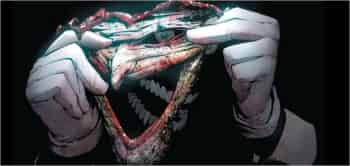Forcing creativity, creating new conventions
Marc Alan Fishman points out that: “[Writers] can’t simply let their comic character live and die with the times. They must constantly be in a cycle or dramatic repartee with one another. They must converge on mighty battlegrounds. They must make odd alliances. They must recalibrate, reinvent, and redefine their very being every few months. The moment they stop, the attention is drawn elsewhere.” (“Wanted, Dead or Alive… Not Both,” www.comicmix.com, May 3, 2014). And in this vein: “The culture of superhero comics encourages repetition; Marvel and DC creators recycle tropes, story structures, and approaches to characterization. Inasmuch as readers approach these comics with certain expectations—to see the last-minute return of a believed-dead hero, the dissolution and reunion of a superteam, etc.—this isn’t necessarily a problem.” (Greg Hunter, “Batman: Death of the Family,” www.tcj.com, February 12, 2014.). And so, “idea generation is the true value of the end product. […] But if we chain the hands of our creative teams and force them to work within the confines of a limited universe, we’re removing the possibility of those teams then creating something truly memorable.” (Marc Alan Fishman, “Captain America, Thor, Changes, Stunts…,” www.comicmix.com, June 26, 2014). Thus the problem isn’t recycling concepts but developing them poorly. “You can figure out the rest. It was mind blowing to see how fandom had embraced Bucky, which more than anything, had to do with the magnificent story that Ed Brubaker was writing.” In a universe without the constraints of life or death, it’s execution that makes concepts—even recycled ones—stand the test of time.



